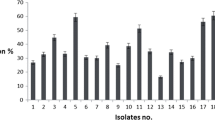Abstract
In the present study, an in vivo model was established to pursue the possible influence of ionophore, salinomycin, on the mobile resistance genes in Clostridium difficile. Fecal samples of 48 healthy adult mice were initially checked for the presence of C. difficile using a species-specific pair of primers. The animals were subsequently divided into the following experimental groups as follows salinomycin + tetracycline, tetracycline, salinomycin, and control (no treatment), for 10 days. Fecal sample was then collected from each group at days 0, 3, and 5 posttreatment, anaerobically enriched in the thioglycolate broth followed by sub-culturing onto blood agar plates. The growth curve and minimum inhibitory concentration (MIC) of groups were then recorded. A PCR assay was also conducted to amplify tet A and tet M genes corresponding to tetracycline. Results showed that salinomycin likely influenced the mobile resistance gene in gram-positive bacteria. Moreover, it may reduce the natural resistance of gram-positive bacteria and also inhibit the transfer of tetracycline mobile resistance gene, in vivo.







Similar content being viewed by others
References
Arcangioli MA, Leroy-Setrin SA, Martel JL, Chaslus-dancla EL (2000) Evolution of chloramphenicol resistance, with emergence of cross-resistance to florfenicol, in bovine Salmonella typhimurium strains implicates definitive phage type (DT) 104. J Med Microbiol 49(1):103–110
Bartlett JG (2008) Historical perspectives on studies of Clostridium difficile and C. difficile infection. Clin Infec Dis 46(Suppl. 1):S4–S11
Bartlett JG, Gorbach SL (1977) Pseudomembranous enterocolitis (antibiotic-related colitis). Adv Intern Med 22:455–476
Butaye P, Devries LA, Haesebrouk F (2003) Antimicrobial growth promoters used in animal feed: effects of less well known antibiotics on gram-positive bacteria. Clin Microbiol 16:175–188
Carlet J, Ben Ali A, Tabah A, Willems V, Philippart F, Chafine A, Garrousteorgeas M, Misset B (2007) Multidrug resistant infections in the ICU: mechanisms, prevention and treatment. In 25 Years of progress and innovation in intensive care medicine. Edited by: Kuhlen R, Moreno R, Ranieri VM, Rhodes A. Berlin, Germany: Medizinisch Wissenschaftliche Verlagsgesellschaft 199–211
Clements AC, Magalhaes RJ, Tatem AJ, Paterson DL, Riley TV (2010) Clostridium difficile PCR ribotype 027: assessing the risks of further worldwide spread. Lancet Infect Dis 10(6):395–404
Cloeckaert A, Praud K, Doublet B, Bertini A, Carattoli A, Butaye P, Imberechts H, Bertrand S, Collard JM, Arlet G, Weill FX (2007) Dissemination of an extended-spectrum-β-lactamase blaTEM-52 gene-carrying IncI1 plasmid in various Salmonella enterica serovars isolated from poultry and humans in Belgium and France between 2001 and 2005. Antimicrob Agents Chemother 51(5):1872–1875
Costa MC, Stampfli HR, Arroyo LG, Pearl DL, Weese JS (2011) Epidemiology of Clostridium difficile on a veal farm: prevalence, molecular characterization and tetracycline resistance. Vet Microbiol 152:379–384
Frost LS, Leplae R, Summers AO, Toussaint A (2005) Mobile genetic elements: the agents of open source evolution. Nature Reviews Microbiol 3(9):722–732
Gholamiandehkordi A, Eeckhaut V, Lanckriet A, Timbermont L, Bjerrum L, Ducatelle R, Haesebrouck F, Immerseel F (2009) Antimicrobial resistance in Clostridium perfringens isolates from broilers in Belgium. Vet Res Commun 33:1031–1037
Houser BA, Soehnlen MK, Wolfgang DR, Lysczek HR, Burns CM, Jayarao BM (2012) Prevalence of Clostridium difficile toxin genes in the feces of veal calves and incidence of ground veal contamination. Food borne Path Dis 9:32–36
Hurley BW, Nguyen CC (2002) The spectrum of pseudomembranous enterocolitis and antibiotic-associated diarrhea. Archives Inter Med 162:2177–2184
Kato H, Kato N, Watanabe K, Iwai N, Nakamura H, Yamamoto T, Suzuki K, Kim SM, Chong Y, Bagus Wasito E (1998) Identification of toxin A-negative, toxin B-positive Clostridium difficile by PCR. J Clin Microbiol 36:2178–2182
Kelly CP, LaMont JT (2008) Clostridium difficile—more difficult than ever. N Engl J Med 359:1932–1940
Kiss D, Bilkei G (2005) A new periparturient disease in Eastern Europe, Clostridium difficile causes postparturient sow losses. Theriogenol 63:17–23
Koene MG, Mevius D, Wagenaar JA, Harmanus C, Hensgens MP, Meetsma AM, Putirulan FF, van Bergen MA, Kuijper EJ (2012) Clostridium difficile in Dutch animals: their presence, characteristics and similarities with human isolates. Clin Microbiol Infec 18:778–784
Marks SL, Kather EJ, Kass PH, Melli AC (2002) Genotypic and phenotypic characterization of Clostridium perfringens and Clostridium difficile in diarrheic and healthy dogs. J Vet Intern Med 16:533–540
Schwaiger K, Holzel CH, Bauer J (2010) Resistance gene patterns of tetracycline resistant Escherichia coli of human and porcine origin. Vet Microbiol 142:329–336
Simango C (2006) Prevalence of Clostridium difficile in the environment in a rural community in Zimbabwe. Trans Royal Soc Trop Med Hygiene 100:1146–1150
Songer JG (2004) The emergence of Clostridium difficile as a pathogen of food animals. Anim Health Res Rev 5:321–326
Tan B (2005) Studies of the complexation reactions of polyether ionophore antibiotics nigericin and salinomycin with lead (II), zinc, calcium, magnesium, sodium and potassium cations (Doctoral dissertation).
Tenover FC, Tickler IA, Persing DH (2012) Antimicrobial-resistant strains of Clostridium difficile from North America. Antimicrob Agents Chemother 56(6):2929–2932
Watanabe K, Watanabe J, Kuramitsu S, Maruyama HB (1981) Comparison of the activity of ionophores with other antibacterial agents against anaerobes. Antimicrob Agents Chemother 19:519–525
Acknowledgments
The authors would like to thank the Research Council of Shiraz University and School of Veterinary Medicine, Shiraz University, for financial and technical support of this study (Grant No. 71-GR-VT-5).
Author information
Authors and Affiliations
Corresponding author
Ethics declarations
Conflict of interest
The authors declare that they have no conflicts of interest.
Ethical approval
All applicable international, national, and/or institutional guidelines for the care and use of animals were followed.
Rights and permissions
About this article
Cite this article
Hosseinzadeh, S., Mirsadeghi, E., Rajaian, H. et al. Effect of ionophore salinomycin on the antibiotic resistance in Clostridium difficile detected in mice. Comp Clin Pathol 25, 1137–1141 (2016). https://doi.org/10.1007/s00580-016-2317-y
Received:
Accepted:
Published:
Issue Date:
DOI: https://doi.org/10.1007/s00580-016-2317-y




